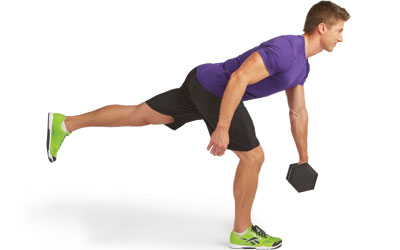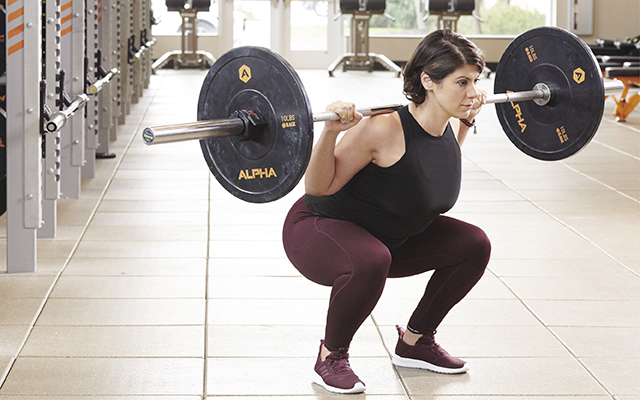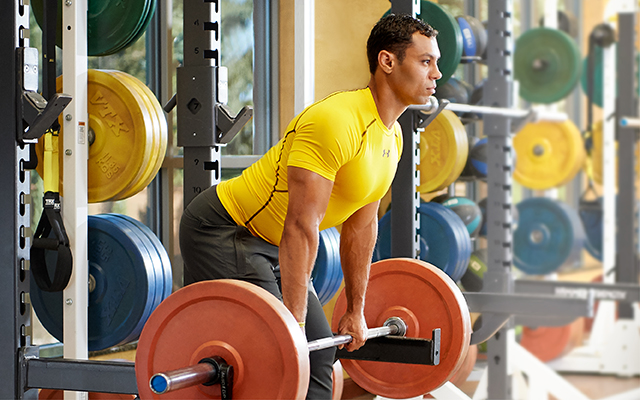Weight machines, treadmills, ellipticals, and other health-club equipment can deliver a well-balanced workout. In daily life and sports, though, our weight is often off center — we twist, we reach, we swing, often favoring one side or the other.
Unilateral movements are where our workouts meet our everyday lives. By challenging one side of the body at a time, these moves decrease imbalances and ensure no muscle is left behind. Each side of the body is forced to work hard without the benefit of the other side helping out.
“Unilateral training helps address muscle imbalances that might go unnoticed during daily activities or workouts,” explains personal trainer and strength coach Meghan Callaway, ACE.
Try taking an arm or leg away from bilateral movements and you’ll feel how much harder your body has to work. Because of their unstable nature, unilateral exercises demand that your core muscles do double duty to ensure you accomplish movements safely and with great form.
Unilateral-training studies show that the approach builds strength on both sides — working and “nonworking.”
It’s easy to transform almost any movement from bilateral to unilateral. Perform deadlifts on a single leg, with a dumbbell or kettlebell in one hand, for example. Do overhead presses with one arm at a time, forcing muscles on the opposite side of the body to serve as stabilizers. Use side planks and Palloff presses to engage the core in an imbalanced state to create more balanced strength. You get the idea.
Callaway designed this workout to make you more stable all around — no matter what instability the world or a workout throws your way.
The Workout
This unilateral, total-body workout organizes six exercises into three supersets (two exercises performed back to back). Complete the prescribed number of sets and reps in each superset before moving on. Rest as long as needed between exercises to keep each rep crisp and sharp.
When selecting weights, err on the side of caution, Callaway suggests. The top priority is making sure you perform each rep safely with your best form, so choose weights accordingly.
Start with what you know you can lift for your first set; if you feel you can perform more than two or three additional good-form reps when you’ve completed the prescribed number, increase the weight on your next round.
Perform this routine two or three times weekly, or incorporate the individual unilateral moves into your existing training plan.
Superset A
Perform two sets of six to 10 reps per side.
A1. Psoas March
With a mini-band around both feet, and your hands pressing into a wall behind your head to engage your core, extend one leg at a time. Strengthens the psoas muscle, a deep-seated core muscle, while improving lumbar-pelvic, shoulder, and scapular stability.
A2. Body-Weight Single-Leg Hip Thrust
With your shoulders in a comfortable position on a sturdy box or bench, and your trunk moving as a single unit, raise and lower your hips by pressing through a single leg. Strengthens your glutes and improves core stability.
Superset B
Perform three sets of eight to 10 reps per side. For the side plank, hold each side for 10 to 30 seconds.
B1. Single-Arm Bent-Over Row
Using a bench for support, row a dumbbell toward your hip. Strengthens the mid- and upper back, and improves grip, scapular-controlled mobility, and core stability.
B2. Copenhagen Side Plank
Place your top leg, bent at a 90-degree angle, on a bench so your ankle and knee are supported. Raise your hips and lift your lower leg off the floor, keeping hips and shoulders squared and stacked. Strengthens your adductors (inner thighs) and core while improving scapular stability.
Superset C
Perform three sets of eight to 10 reps per side.
C1. Tall Kneeling Single-Arm Landmine Press
Kneeling on the floor, press the barbell away from you while keeping your core and hips engaged. Strengthens your chest, shoulders, and triceps, and improves shoulder- and scapular-controlled mobility and lumbar-pelvic stability.
C2. Kettlebell Single-Arm Suitcase Deadlift
With your core centered and hips and shoulders level, deadlift a kettlebell at your side. Strengthens the glutes and hamstrings and improves shoulder and lumbar-pelvic stability.
This originally appeared as “One Side at a Time” in the October 2019 print issue of Experience Life.




This Post Has 0 Comments